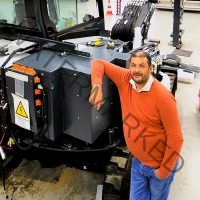Does energy recovery on the boom contribute to a longer operational time for an electric excavator?
Van der Spek Vianen and GMB are set to test this in practice on a new electric Hyundai HX260ALE, which comes equipped with a new EPFC system featuring an electronically proportional controlled main pump for the hydraulics straight from the factory.
The hybrid system for energy recovery on the hydraulics is not new. Van der Spek Vianen has previously applied the French ECO’nergie system, but only on conventional diesel machines. The principle is that when the boom lowers, pressure is built up in a nitrogen-filled cylinder. This process doesn’t consume energy as gravity does the work. The high pressure in the nitrogen cylinder is then reused when lifting the boom. This is already the sixth time that Van der Spek has installed this hybrid system for GMB. Several manufacturers also use similar systems, either for lowering or swinging the boom.


Fuel Savings
The exact fuel savings of the system are difficult to prove as conditions are never entirely comparable, explains Arjan Uittenbogaard of Van der Spek Vianen. “We did measure at companies using three Hyundai HX300 machines deployed at crushers. Without the system, the consumption was 20 liters per hour. For one hybrid machine, it was slightly over 13 liters per hour and for the other, 15 liters per hour. However, the crane usage and working methods were slightly different there too.”
Faster Lifting
While fuel savings are challenging to measure, it is evident that the system provides additional energy gains. Initially, this results in a higher speed when lifting the boom. “This allows you to work faster. You can do the same work with a 30-ton machine as you would with a standard 35-ton machine. To accurately determine fuel savings and efficiency, you should look at consumption per cubic meter rather than per hour.”
Electronic Pump Control
In the new electric Hyundai HX260ALE, which Van der Spek had converted for GMB by UMS, this ‘problem’ was well resolved. The new Hyundai machines are equipped with an EPFC system that electronically controls the main hydraulic pump and offers power and fine mode control options. This allows the speed of lifting the boom using the hybrid system to be well adjusted. It is now set to match that of a conventional machine. As a result, all the gains from the hybrid system are directed toward energy savings, while the efficiency and performance of the machine remain the same.
Full-Day Operation
This is particularly important for a battery-powered machine, as its usability depends primarily on how many hours it can operate per day. With three battery packs of 130 kW each, a machine can, in principle, operate for eight hours, but not if it has to break heavy clay all day. A larger battery pack is, of course, possible, but its cost is significantly higher than a standard pack, and it also increases the weight. Both are undesirable, which is why Van der Spek and GMB looked for other solutions.
GMB already operates two electric Hyundai excavators. The third machine will be fitted with the hybrid energy recovery system; a nitrogen accumulator is also placed under the boom.
Less Space
Installing this system on an electric machine required a different approach compared to a conventional diesel machine. Due to the battery pack, there is less space at the rear of the machine to place the required cylinder. Therefore, a slimmer and longer piston accumulator was chosen.
Optimal Collaboration
The hybrid system can also be switched off. However, in practice, operators do not turn it off, according to Uittenbogaard. And with the new EPFC system, this should no longer be necessary. The hybrid system and the pump now work together optimally when lifting, making the system even advantageous for finishing tasks.



